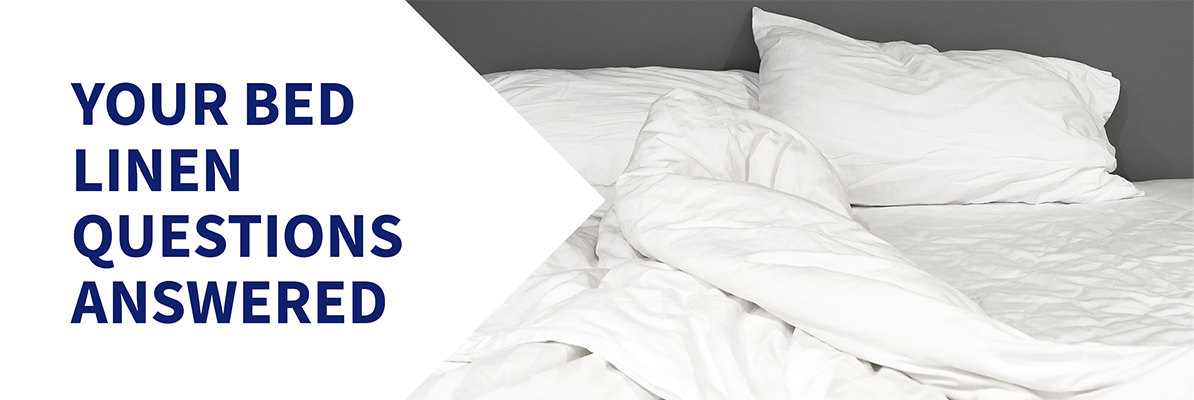
YOUR BED LINEN QUESTIONS ANSWERED
How is a sheet made?
Sheeting fabric is made up of fibres running in two directions at right angles to each other, known as the warp and the weft. The warp runs lengthwise and the weft runs across the width. During the weaving process these threads are combined in line with a given pattern. By varying the types of cotton used for each thread type, and by altering the weave pattern, it is possible to produce different bed linen types.
How does a sheet work?
The fibres in a sheet construction are designed to keep you comfortable while you sleep by dispersing moisture.
How do you determine yarn quality?
The quality of the yarn is largely a function of the length of the staple, or cotton fibre. This is because long-staple cotton can be spun into a smoother, stronger, much finer yarn, so that it is possible to weave more threads per inch into the fabric, resulting in a higher thread count.
Certainly, many inferior, short-staple cotton yarns can be jammed into a square inch to create a high thread count, but the resulting fabric can feel heavy and coarse.
What is thread count?
Thread count is the number of horizontal and vertical threads woven into a square inch of fabric. These consist of vertical threads (warp) and horizontal threads (weft) woven together.
Using finer threads means more per square inch of fabric which makes the fabric softer and more luxurious.
What are the benefits of a polyester/cotton blend?
By blending polyester and cotton you get a product that is easy care.
The combination of polyester and cotton results in a product that is durable, feels smooth and crisp, retains its shape, crease resistant, launders easily, dries quickly and requires little or no ironing.
What is percale?
Percale is a closely woven plain weave fabric with a 180 thread count (imperial measurement) or above. It is usually smooth and luxurious. Percale can be used to describe both pure cotton and cotton/polyester blended fabrics.
What is combed cotton?
Cotton fibres are put through a ‘combing’ process, which removes the rougher and poor quality fibres, producing a bed linen that feels smooth, crisp and cool to the touch.
What is cotton sateen/dobby?
Sateen is a woven structure where the maximum amount of weft shows on the face of the fabric. It is designed to reflect light, giving a glossy, satiny and smooth feel, especially when more lustrous fibres are used.
A dobby design is created on a loom with multiple shafts creating a textured finish usually in a geometric design like a check or stripe. Made from a fine-combed cotton yarn and woven in a way that produces an elegant sheen finish. Cotton sateen feels luxuriously soft and smooth against the skin.
Will my sheets maintain their whiteness?
Your sheets should remain sparkling white with the proper use of good chemicals and by adhering to the correct washing procedures. However, greying can occur through impure water quality and the over use of optical brighteners which can cause colour loss.
Will my sheets shrink?
All sheets shrink when they are first washed. The extent of the shrinkage is influenced by the sizes of the different yarns used in the sheet, the density of the weave, differences in weave pattern from one sheet to another, and importantly the drying temperatures used when drying bed linen.
Will my printed sheets fade?
Drying printed sheets in direct sunlight will result in colour loss.
How long should a sheet last?
A sheet's life depends on its care, on how the sheet has been made and the laundering practices of the hotel. Extraneous factors such as heat (from laundering and drying), chemicals and physical treatment all contribute to the wearing process. However, to ensure your sheets have a long and commercial life it all begins with buying well made bedlinen.
How should I care for my sheets?
Washing
Always wash new bed linen before use to remove any dust or loose fibres and follow the washing instructions on the sewn in care label. Good quality bed linen with a higher thread count actually improves and becomes softer with washing. Just purchased printed sheets may feel a bit rough at first as the dye used is extra thick and has a surface texture. They'll soften nicely after a few washings. Machine wash your bed linen at 70 o c maximum. Do not overload the machine, as this causes creasing. Wash dark colours separately. Do not dry clean.
Ironing
To make ironing easier, iron while still damp or dampen slightly or use steam to smooth out creases. Take care not to scorch whites.
View the Caring For Your Bedding section for detailed information.



